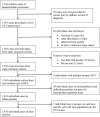Increased Risk of Hepatocellular Carcinoma Associated With Neighborhood Concentrated Disadvantage
- PMID: 30254987
- PMCID: PMC6141716
- DOI: 10.3389/fonc.2018.00375
Increased Risk of Hepatocellular Carcinoma Associated With Neighborhood Concentrated Disadvantage
Abstract
Purpose: Over the past three decades, Hepatocellular Carcinoma (HCC) is one of few cancers for which incidence has increased in the United States (US). It is likely social determinants at the population level are driving this increase. We designed a population-based study to explore whether social determinants at the neighborhood level are geographically associated with HCC incidence in Louisiana by examining the association of HCC incidence with neighborhood concentrated disadvantage. Methods: Primary HCC cases diagnosed from 2008 to 2012 identified from the Louisiana Tumor Registry were geocoded to census tract of residence at the time of diagnosis. Neighborhood concentrated disadvantage index (CDI) for each census tract was calculated according to the PhenX Toolkit data protocol based on population and socioeconomic measures from the US Census. The incidence of HCC was modeled using multilevel binomial regression with individuals nested within neighborhoods. Results: The study included 1,418 HCC cases. Incidence of HCC was greater among males than females and among black than white. In multilevel models controlling for age, race, and sex, neighborhood CDI was positively associated with the incidence of HCC. A one standard deviation increase in CDI was associated with a 22% increase in HCC risk [Risk Ratio (RR) = 1.22; 95% CI (1.15, 1.31)]. Adjusting for contextual effects of an individual's neighborhood reduced the disparity in HCC incidence. Conclusion: Neighborhood concentrated disadvantage, a robust measure of an adverse social environment, was found to be a geographically associated with HCC incidence. Differential exposure to neighborhoods characterized by concentrated disadvantage partially explained the racial disparity in HCC for Louisiana. Our results suggest that increasing rates of HCC, and existing racial disparities for the disease, are partially explained by measures of an adverse social environment.
Keywords: hepatocellular carcinoma; multilevel analysis; neighborhood concentrated disadvantage; neighborhood environment; social determinants.
Figures
Similar articles
-
Neighborhood disadvantage and racial disparities in colorectal cancer incidence: a population-based study in Louisiana.Ann Epidemiol. 2018 May;28(5):316-321.e2. doi: 10.1016/j.annepidem.2018.02.004. Epub 2018 Mar 22. Ann Epidemiol. 2018. PMID: 29678311 Free PMC article.
-
Neighborhood-level deprivation mediates racial and ethnic disparities in HCC diagnosis in Texas.Hepatol Commun. 2024 Oct 17;8(11):e0536. doi: 10.1097/HC9.0000000000000536. eCollection 2024 Nov 1. Hepatol Commun. 2024. PMID: 39761006 Free PMC article.
-
Neighborhood Social Determinants of Triple Negative Breast Cancer.Front Public Health. 2019 Feb 18;7:18. doi: 10.3389/fpubh.2019.00018. eCollection 2019. Front Public Health. 2019. PMID: 30834239 Free PMC article.
-
Socioeconomic and Racial Segregation and COVID-19: Concentrated Disadvantage and Black Concentration in Association with COVID-19 Deaths in the USA.J Racial Ethn Health Disparities. 2022 Feb;9(1):367-375. doi: 10.1007/s40615-021-00965-1. Epub 2021 Jan 19. J Racial Ethn Health Disparities. 2022. PMID: 33469872 Free PMC article.
-
Social Genomic Determinants of Health: Understanding the Molecular Pathways by Which Neighborhood Disadvantage Affects Cancer Outcomes.J Clin Oncol. 2024 Oct 20;42(30):3618-3627. doi: 10.1200/JCO.23.02780. Epub 2024 Aug 23. J Clin Oncol. 2024. PMID: 39178356 Review.
Cited by
-
Geographic disparities in access to liver transplantation.Liver Transpl. 2023 Sep 1;29(9):987-997. doi: 10.1097/LVT.0000000000000182. Epub 2023 May 29. Liver Transpl. 2023. PMID: 37232214 Free PMC article. Review.
-
Hepatocellular carcinoma in Pacific Islanders: comparison of Pacific Island-born vs. US-born.Hepatoma Res. 2023;9:7. doi: 10.20517/2394-5079.2022.85. Epub 2023 Mar 17. Hepatoma Res. 2023. PMID: 37035453 Free PMC article.
-
Racial and Sex Disparities in Hepatocellular Carcinoma in the USA.Curr Hepatol Rep. 2020 Dec;19(4):462-469. doi: 10.1007/s11901-020-00554-6. Epub 2020 Nov 12. Curr Hepatol Rep. 2020. PMID: 33828937 Free PMC article.
-
Impact of social determinants of health on hepatocellular carcinoma surveillance, treatment, and health care costs.Hepatol Commun. 2024 Oct 10;8(11):e0517. doi: 10.1097/HC9.0000000000000517. eCollection 2024 Nov 1. Hepatol Commun. 2024. PMID: 39392769 Free PMC article.
-
The role of racial segregation in treatment and outcomes among patients with hepatocellular carcinoma.HPB (Oxford). 2021 Jun;23(6):854-860. doi: 10.1016/j.hpb.2020.12.011. Epub 2021 Jan 19. HPB (Oxford). 2021. PMID: 33536151 Free PMC article.
References
Grants and funding
LinkOut - more resources
Full Text Sources
Other Literature Sources
Miscellaneous




